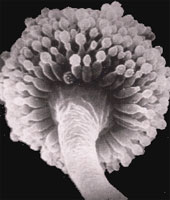Saprophyte abundance
 Major fungi collection centres in India, include the Indian Agricultural Research Institute (IARI), New Delhi, Punjab University, Chandigarh, Madras University, Chennai, Lucknow University, Uttar Pradesh, the Allahabad University, Uttar Pradesh, Calcutta University, West Bengal, Forest Research Institute, Dehra Dun, Ut tar Pradesh, Agaharkar Herbarium, Pune, Maharashtra, and the Indian Type Culture Collection (ITCC).
Major fungi collection centres in India, include the Indian Agricultural Research Institute (IARI), New Delhi, Punjab University, Chandigarh, Madras University, Chennai, Lucknow University, Uttar Pradesh, the Allahabad University, Uttar Pradesh, Calcutta University, West Bengal, Forest Research Institute, Dehra Dun, Ut tar Pradesh, Agaharkar Herbarium, Pune, Maharashtra, and the Indian Type Culture Collection (ITCC).
The ITCC holds about 4,400 cultures of fungi of agricultural importance, identifies over 700 cultures every year and has supplied over 24,000 cultures free of cost to researchers in India and abroad. The infra- structure of the ITCC is, however, poor and this limits its services.
Set up jointly by the Council of Scientific and Industrial Research and Department of Biotechnology in 1986, the Microbial Type Culture Collection at the Institute of Microbial Technology, Chandigarh, aims at meeting industry requirements. It maintains a collection of yeasts, bacteria and fungi, chiefly of industrial importance.
The IARI has established a facility in the institute for rhizobia, a microbe of agricultural importance. Rhizobia grow on the roots of certain plants and increase the availability of nitrogen to the plants. This improves the soil and plant health. About 1000 cultures are available With this centre, which have been preserved as per international guidelines with the help of the International Centre for research in the Semi-Arid Tropics.
The National Facility for Blue-Green Algal Collections has been set up at IARI, New Delhi where 600 cultures are being maintained in pure form after morphological and physiological characterisation. During 1955-96, 50 strains belonging to 54 different genera were isolated from rice-field soils of eastern India.
Established in 1993 by the Indian Council Of Agricultural Research (ICAR), the Advanced Centre of Biosystematics at IARI conserves, classifies and identifies biodiverse forms of insects, nematodes, fungi, bacteria and viruses. The government plans to establish National Bureau of Agricultural Microorganisms to bring together and be the custodian of agricultural microbial genetic resources in India, the main objectives of which will be to characterise, maintain and reserve pure cultures of microbes.
Experts admit that the success of such a venture will depend on the evolution of a patenting system for microorganisms and the funds available during the 9th Five Year Plan. The ICAR also plans to set up a National Facility for Culture Collection of Viruses and a National Research Centre for Plant Virology. Viruses are extremely difficult and expensive to culture and maintain.
